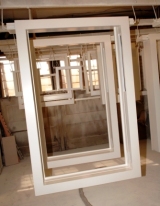On Tuesday 9th October the BWF was invited with other members of the fenestration industry to a meeting at The Department of Communities and Local Government (DCLG) to discuss the responses to the consultation on part L of the Building Regulations for England. This meeting was to be a chance for AECOM, the Government’s consultants who are working on the amended guidance, to understand the reasoning behind the responses from the various trade associations that have an interest in the thermal performance of windows, doors, roof windows and rooflights.
The discussion relating to windows focused on these key issues:
– Maximum U-values and energy ratings for replacement windows
– The option to refer only to centre pane U-values for compliance
– Design limits for whole window U-values in new build projects.
It was an opportunity for the BWF to raise concerns that whole window U-values below 1.5 W/m2K would result in the need for triple glazing and that the associated increases in the strength of window components and hardware and would also reduce the Green Guide rating for a window. We did, however, recognise that Window Energy Ratings (WER) did offer a compliance route that could potentially be achieved with a poorer U-value (note: B rated timber windows on the BFRC website have U-values which range from 1.7 to 1.4 W/m2K).
 The current costs associated with energy ratings could be a barrier to small joinery manufacturers, but the BWF is currently working on ways to reduce these costs making energy ratings more attractive.
The current costs associated with energy ratings could be a barrier to small joinery manufacturers, but the BWF is currently working on ways to reduce these costs making energy ratings more attractive.
If centre pane U-values were to be retained then there should be clearer guidance on when and where they could be used and the minimum requirement should be increased to a U-value of 1.1 W/m2K, or at least in line with changes to U-values. It was noted that the requirement for centre-pane U-value had not changed from 1.2 W/m2K since it was introduced in 2002.
There was also a discussion around the effects of other performance characteristics of glass units on the U-value or energy rating of a window. Characteristics such as sound attenuation, safety, robustness and obscuration could be detrimental to the thermal performance of a window and it was suggested that only the performance of a “standard” specification window should be used for compliance with Part L. However, further consideration of this issue would be required.
In the discussion about doorsets, it was considered that a change from a U-value of 1.8 to 1.4 W/m2K was very significant and would be difficult to achieve in traditional stile and rail type doors. In order to be consistent with the Governments Standard Assessment Procedure for the Energy Rating of Dwellings (SAP 2012) the bandings for doorsets in table 6.1 should be employed. The bandings are as follows:
– Solid doorsets with glazed area less than 30%,
– Glazed doorsets with a glazed area between 30% and 60%
– Doorsets with a glazed area greater than 60% (types probably limited to pairs of doors, patio doors and folding-sliding doors), which would follow the same requirements as windows.
This could lead to a range of U-values for doorsets which would be:
1.8 W/m2K for solid doorsets
1.6 W/m2K for glazed doorsets
1.5 W/m2K for other doorsets.
It was noted that the Doorset Energy Rating (DSER) system for doors offered model door types for determining energy ratings and these models could be included in an update to BR443 as it was thought to require reworking to provide clearer information on model windows and doorsets. It was also considered that a second tier document might be required to provide better information relating to Doorset and Window Energy Ratings.
At the end of the meeting the issue of non-compliance was raised with concerns raised that tighter performance requirements would lead to greater incidence of windows and doorsets not meeting the minimum requirements. DCLG were aware of this issue and stated that penalties for non-compliance were being strengthened.
The discussions held during the meeting would be reviewed by DCLG and BRAC (Building Regulations Advisory Committee) as part of finalising the recommendations to ministers and the final content of Approved Document L 2013.